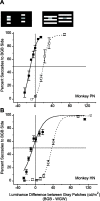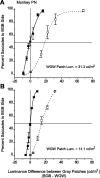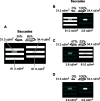Perception of brightness and brightness illusions in the macaque monkey
- PMID: 12417687
- PMCID: PMC6758023
- DOI: 10.1523/JNEUROSCI.22-21-09618.2002
Perception of brightness and brightness illusions in the macaque monkey
Abstract
Recent physiological studies show that neural responses correlated with the perception of brightness are found in cortical area V1 but not earlier in the visual pathway (Kayama et al., 1979; Reid and Shapley, 1989; Squatrito et al., 1990; Komatsu et al., 1996; Rossi et al., 1996; MacEvoy et al., 1998; Rossi and Paradiso, 1999; Hung et al., 2001; Kinoshita and Komatsu, 2001; MacEvoy and Paradiso, 2001). However, these studies are based on comparisons of neural responses in animals with brightness perception in humans. Very little is known about the perception of brightness in animals typically used in physiological experiments. In this study, we quantify brightness discrimination, brightness induction, and White's effect in macaque monkeys. The results show that, qualitatively and quantitatively, the perception of brightness in macaques and humans is quite similar. This similarity may be an indication of common underlying neural computations in the two species.
Figures






References
-
- Adelson EH. Perceptual organization and the judgement of brightness. Science. 1993;262:2042–2044. - PubMed
-
- Anderson BL. A theory of illusory lightness and transparency in monocular and binocular images: the role of contour junctions. Perception. 1997;26:419–453. - PubMed
-
- Ash P. The sensory capacities of infrahuman mammals: vision, audition, gustation. Psychol Bull. 1951;48:289–326. - PubMed
-
- Blakeslee B, McCourt ME. A multiscale spatial filtering account of the White effect, simultaneous brightness contrast and grating induction. Vision Res. 1999;39:4361–4377. - PubMed
-
- Brooks BA. Neurophysiological correlates of brightness discrimination in the lateral geniculate nucleus of the squirrel monkey. Exp Brain Res. 1966;2:1–17. - PubMed
Publication types
MeSH terms
LinkOut - more resources
Full Text Sources
